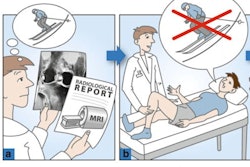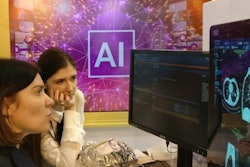
For a couple of years now, there has been an increasing restlessness among the professional radiological societies. The great advances and possibilities promised by artificial intelligence (AI) are fascinating -- and, for some, worrying.1, 2, 3
 Dr. Andreas Gutzeit from Lucerne, Switzerland.
Dr. Andreas Gutzeit from Lucerne, Switzerland.Many questions arise: Will radiology departments still exist in 10 years time? How will our profession change? And very worried people even ask themselves: Will I lose my job soon because of the machines?
At ECR in Vienna, these questions have been discussed more and more intensively for about two years now, and one can hardly escape the topic anymore. Research containing the technical terms "AI" and "radiology" confirms the suspicion: Nearly 6,000 publications can be found, and the number is growing extremely fast.
First, I should point out I am not an AI expert, but I would like to see more practical examples of this technology at the moment and would like to know what I can do personally to prepare myself for this future with intelligent machines.
The main purpose of radiology
With the exception of interventional radiology, radiology is concerned with the rapid and reliable diagnosis and assessment of disease progression. This is our main task, and it is at the core of our profession. But for whom do we do it? For our referring physicians? For our employer? We do our work primarily for patients. This is our primary core group. We radiologists are certainly aware of this, but do our patients also know it?
In an Irish study, patients were asked whether they knew who was reading their pictures. The researchers found that 76% of patients did not know what a radiologist does, and many patients thought the doctor was a radiographer who produces images.4 The same study asked whether patients were aware of the importance of radiology in diagnostics. Most patients did not know what the radiologist did, and some suspected that the radiologist was somebody who asks patients if they have allergies.
Another study found that most patients had no idea about the importance of the radiologist and that often they were influenced by TV series.5 Where does this lack of knowledge of patients come from? This is due to the fact that we as radiologists have sometimes distanced ourselves too far from the patient. Different studies have shown that 80% to 90% of radiologists no longer have any patient contact.6, 7
Meeting the challenges posed by AI
If we believe the numerous publications and contributions of recent years, our field will undergo significant change in the coming years. We cannot assume that radiologists will be unemployed or redundant in the foreseeable future, but if these concerns persist, one way to help ourselves would be to make it clearer to patients what enormous expertise we have and what decisive influence we have in each patient's clinical outcome.
A Swiss study showed that more than 81% of patients value a final discussion with the radiologist as an important part of the service.6 That could be a solution to clearly show the worth of radiology services.
If we want to present ourselves as an important player, we will have to communicate and interact much more with patients in the future, especially in the age of AI. If we are afraid of robots, we should not stay in the background and behave like machines. We must be empathetic doctors who are committed to the health of our patients.
AI will be very exciting if we can effectively be relieved from some of the repetitive and time-consuming aspects of our work and devote ourselves more to medical care for patients.
Dr. Andreas Gutzeit is a professor of radiology and holds a degree in health management and communication psychology. He teaches at ETH Zurich and the University of Salzburg and works as a radiologist at the Hirslanden Klinik St. Anna in Lucerne, Switzerland.
References
- Pakdemirli E. Artificial intelligence in radiology: Friend or foe? Where are we now and where are we heading? Acta Radiol Open. 2019;21(8):2.
- Auffermann WF, Gozansky EK, Tridandapani S. Artificial Intelligence in cardiothoracic radiology. AJR Am J Roentgenol. 19 February 2019.
- Gallix B, Chong J. Artificial intelligence in radiology: Who's afraid of the big bad wolf? Eur Radiol. 2019;29(4):1637-1639.
- O'Mahony N, McCarthy E, McDermott R, O'Keeffe S. Who's the doctor? Patients' perceptions of the role of the breast radiologist: A lesson for all radiologists. Br J Radiol. 2012;85(1020):e1184-e1189.
- Heye T, Merkle EM, Leyendecker JR, Boll DT, Gupta RT. Portrayal of radiology in a major medical television series: How does it influence the perception of radiology among patients and radiology professionals? Eur Radiol. 2016;26(8):2863-2869.
- Gutzeit A, Heiland R, Sudarski S, et al. Direct communication between radiologists and patients following imaging examinations. Should radiologists rethink their patient care? Eur Radiol. 2019;29(1):224-231.
- Glazer GM, Ruiz-Wibbelsmann JA. The invisible radiologist. Radiology. 2011;258(1):18-22.



















